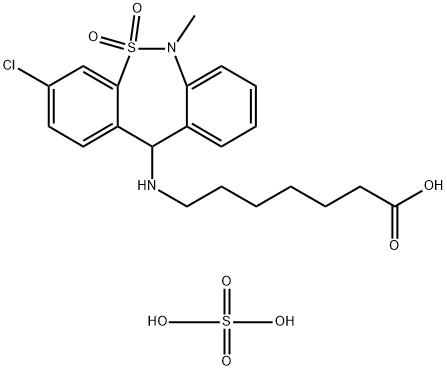tianeptine sulfate
|
|
Sicherheit
tianeptine sulfate Chemische Eigenschaften,Einsatz,Produktion Methoden
Physikalische Eigenschaften
Tianeptine sulfate is more stable than tianeptine sodium which is notoriously unstable; it reacts to both atmospheric moisture and to light. Tianeptine sulfate on the other hand does not absorb the water from air so it does not clump.Tianeptine sulfate is soluble and cam be mixed easily with water.Verwenden
Tianeptine sulfate is classified as a selective serotonin reuptake enhancer (SSRE) used to treat depression. Tianeptine was developed in France in the 1960s and has been used throughout the last part of the 2000s. Tianeptine sulfate improves brain neuroplasticity and decreases depression. Neuroplasticity is the brain’s ability to adapt and change when learning; contributing to better cognitive performance and improved learning ability.Application
Tianeptine sulfate can be used to provide pharmaceutical compositions for the treatment of conditions known in the art, such as one or more depressive disorders, irritable bowel syndrome (IBS), attention deficit hyperactivity disorder (ADHD), one or more neurodegenerative diseases, and asthma.Pharmakokinetik
The effect tianeptine sulfate lasts longer than tianeptine sodium. Tianeptine sulfate is absorbed by the body slowly so its effect is also extended and that means less dosing.Nebenwirkungen
Tianeptine is prescribed as an antidepresant in Europe. The prescription drug is produced as tianeptine sodium. The most common adverse effects of Tianeptine are nausea, constipation, abdominal pain, headache, dizziness and changes in dreaming. Anticholinergic effects occur less often with tianeptine than with tricyclic agents. Hepatoxicity is rare.tianeptine sulfate Upstream-Materialien And Downstream Produkte
Upstream-Materialien
Downstream Produkte
tianeptine sulfate Anbieter Lieferant Produzent Hersteller Vertrieb H?ndler.
Global( 147)Lieferanten
| Firmenname | Telefon | Land | Produktkatalog | Edge Rate | |
|---|---|---|---|---|---|
| Baoji Guokang Bio-Technology Co., Ltd. | 0917-3909592 13892490616 |
gksales1@gk-bio.com | China | 9311 | 58 |
| Dorne Chemical Technology co. LTD | +86-86-13583358881 +8618560316533 |
Ethan@dornechem.com | China | 3097 | 58 |
| Shijiazhuang Jianxin Biotechnology Co., LTD | +undefined-86-1906231316-9 +undefined86-19062313169 |
liyingjian1997@gmail.com | China | 712 | 58 |
| Strong peptide cross-border e-commerce Co. LTD | +undefined13930052870 |
qt01@qiangtaipharm.com | China | 84 | 58 |
| Hebei Lingding Biotechnology Co., Ltd. | +86-18031140164 +86-19933155420 |
erin@hbldbiotech.com | China | 92 | 58 |
| Wuhan Circle Star Chem-medical Technology Co.,Ltd | +undefined13437180835 |
Janel@circlestar-chem.com | China | 1001 | 58 |
| Hebei Yanxi Chemical Co., Ltd. | +8617531153977 |
allison@yan-xi.com | China | 5856 | 58 |
| Wuhan Han Sheng New Material Technology Co.,Ltd | +8617798174412 |
admin01@hsnm.com.cn | China | 2097 | 58 |
| Guangzhou Tengyue Chemical Co., Ltd. | +86-86-18148706580 +8618826483838 |
evan@tyvovo.com | China | 148 | 58 |
| Anhui Ruihan Technology Co., Ltd | +8617756083858 |
daisy@anhuiruihan.com | China | 973 | 58 |
1224690-84-9()Verwandte Suche:
Natrium-7-[(3-chlor-6,11-dihydro-6-methyldibenzo[c,f][1,2]thiazepin-11-yl)amino]heptanoat-S,S-dioxid
- tianeptine sulfate
- (Thiazepin-11-ylAmino)Heptanoic Acid Semisulfate Monohydrate Tianeptine Semisulfate Monohydrate
- 7-[(3-Chloro-6,11-dihydro-6-methyl-5,5-dioxidodibenzo[c,f][1,2]thiazepin-11-yl)amino]heptanoic acid sulfate hydrate (2:1:2)
- 7-[(3-Chloro-6-methyl-5,5-dioxido-6,11-dihydrodibenzo[c,f][1,2]thiazepin-11-yl)amino]heptanoic acid sulfate hydrate (2:1:2)
- THM Synonyms: Tianeptine hemisulfate monohydrate
- Tong Kangzuo
- tianeptine sodium Tianeptine sulfate
- Tineptine sulphate powder / Tianeptin sulfate
- Tianeptine Semisulfate Monohydrate
- TTianeptine sulfateianeptine sulfate
- Tianeptine sulphate powder
- Thiazepin-11-ylAmino)Heptanoic Acid Semisulfate
- Tianeptine hemisulfate monohydrate (THM)
- THM
- Tianeptine hemisulfate hydrate
- Tianeptine Semisulfate Monohydrate Tianeptine Sulfate
- Tianeptine SulfateSalt
- 1224690-84-9
- 2C21H25ClN2O4SH2SO42H2O
- 1224690-84-9
- API







